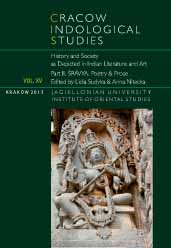Sanskritization of Regional History: A Study in the Historiography of Atula’s Mūṣikavaṃśa
Sanskritization of Regional History: A Study in the Historiography of Atula’s Mūṣikavaṃśa
Author(s): Rajendran ChettiarthodiSubject(s): Cultural history
Published by: KSIĘGARNIA AKADEMICKA Sp. z o.o.
Keywords: Sanskritization; regional history; Mūṣikavaṃśa; historical mahākāvyas; Atula; King Śrīkaṇṭha; Rājataraṅginī; Kalhaṇa; Kolattunādu kingdom of North Kerala
Summary/Abstract: Mūṣikavaṃśa (also known as Mūṣakavaṃśa) is a historical mahākāvya written by Atula, who was a court poet of King Śrīkaṇṭha, alias Rājadharma, who lived in the 11th century AD. The work antedates even Rājataraṅginī of Kalhaṇa, which is regarded as one of the earliest historical mahākāvyas in Sanskrit. The work deals with the history of the Mūṣika dynasty, which ruled the Kolattunādu kingdom of North Kerala. The earlier parts of the mahākāvya deal with legendary matters, such as the mythical origin of the lineage; but as the work progresses, it deals with many historical data including details of the kings, geographical features, temples and other centres of culture, various religious sects, art, literature and architecture, commerce and shipping. This work, one of the pioneer efforts to represent provincial history in classical garb, using the literary conventions of the mahākāvya genre, as well as a virtual storehouse of knowledge regarding the history of Northern Kerala, is an interesting amalgam of myths and facts. An analysis of the work will yield rich insights into ancient Indian historiography. The present paper is an attempt to investigate the manner in which poet Atula makes use of facts of regional history to fit into the structure of a Sanskrit mahākāvya.
Journal: Cracow Indological Studies
- Issue Year: 2013
- Issue No: 15
- Page Range: 67-80
- Page Count: 14
- Language: English

